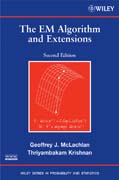
Since its inception in 1977, the Expectation-Maximization (EM) algorithm has been the subject of intense scrutiny, dozens of applications, numerous extensions, and thousands of publications. The algorithm and its extensions are now standard tools applied to incomplete data problems in virtually every field in which statistical methods are used. The EM Algorithm and Extensions, Second Edition remains the only single source that offers a complete and unified treatment of the theory, methodology, and applications of the subject. INDICE: Preface to the Second Edition. Preface to the First Edition. List of Examples. 1. General Introduction. 1.1 Introduction. 1.2 Maximum LikelihoodEstimation. 1.3 Newton-Type Methods. 1.4 Introductory Examples. 1.5 Formulation of the EM Algorithm. 1.6 EM Algorithm for MAP and MPL Estimation. 1.7 BriefSummary of the Properties of EM Algorithm. 1.8 History of the EM Algorithm. 1.9 Overview of the Book. 1.10 Notations. 2. Examples of the EM Algorithm. 2.1 Introduction. 2.2 Multivariate Data with Missing Values. 2.3 Least Square withthe Missing Data. 2.4 Example 2.4: Multinomial with Complex Cell Structure. 2.5 Example 2.5: Analysis of PET and SPECT Data. 2.6 Example 2.6: Multivariate t-Distribution (Known D.F.). 2.7 Finite Normal Mixtures. 2.8 Example 2.9: Grouped and Truncated Data. 2.9 Example 2.10: A Hidden Markov AR(1) Model. 3. Basic Theory of the EM Algorithm. 3.1 Introduction. 3.2 Monotonicity of a Generalized EM Algorithm. 3.3 Monotonicity of a Generalized EM Algorithm. 3.4 Convergence of an EM Sequence to a Stationary Value. 3.5 Convergence of an EM Sequenceof Iterates. 3.6 Examples of Nontypical Behavior of an EM (GEM) Sequence. 3.7Score Statistic. 3.8 Missing Information. 3.9 Rate of Convergence of the EM Algorithm. 4. Standard Errors and Speeding up Convergence. 4.1 Introduction. 4.2 Observed Information Matrix. 4.3 Approximations to Observed Information Matrix: i.i.d. Case. 4.4 Observed Information Matrix for Grouped Data. 4.5 Supplemented EM Algorithm. 4.6 Bookstrap Approach to Standard Error Approximation. 4.7 Bakers, Louis, and Oakes Methods for Standard Error Computation. 4.8 Acceleration of the EM Algorithm via Aitkens Method. 4.9 An Aitken Acceleration-BasedStopping Criterion. 4.10 conjugate Gradient Acceleration of EM Algorithm. 4.11 Hybrid Methods for Finding the MLE. 4.12 A GEM Algorithm Based on One Newton-Raphson Algorithm. 4.13 EM gradient Algorithm. 4.14 A Quasi-Newton Acceleration of the EM Algorithm. 4.15 Ikeda Acceleration. 5. Extension of the EM Algorithm. 5.1 Introduction. 5.2 ECM Algorithm. 5.3 Multicycle ECM Algorithm. 5.4 Example 5.2: Normal Mixtures with Equal Correlations. 5.5 Example 5.3: Mixture Models for Survival Data. 5.6 Example 5.4: Contingency Tables with Incomplete Data. 5.7 ECME Algorithm. 5.8 Example 5.5: MLE of t-Distribution with the Unknown D.F. 5.9 Example 5.6: Variance Components. 5.10 Linear Mixed Models. 5.11 Example 5.8: Factor Analysis. 5.12 Efficient Data Augmentation. 5.13 Alternating ECM Algorithm. 5.14 Example 5.9: Mixtures of Factor Analyzers. 5.15 Parameter-Expanded EM (PX-EM) Algorithm. 5.16 EMS Algorithm. 5.17 One-Step-Late Algorithm. 5.18 Variance Estimation for Penalized EM and OSL Algorithms. 5.19 Incremental EM. 5.20 Linear Inverse problems. 6. Monte Carlo Versions of the EM Algorithm. 6.1 Introduction. 6.2 Monte Carlo Techniques. 6.3 Monte Carlo EM. 6.4 Data Augmentation. 6.5 Bayesian EM. 6.6 I.I.D. Monte Carlo Algorithm. 6.7 Markov Chain Monte Carlo Algorithms. 6.8 Gibbs Sampling. 6.9 Examples of MCMC Algorithms. 6.10 Relationship of EM to Gibbs Sampling. 6.11 Data Augmentation and Gibbs Sampling. 6.12 Empirical Bayes and EM. 6.13 Multiple Imputation. 6.14 Missing-Data Mechanism, Ignorability, and EM Algorithm. 7. Some Generalization ofthe EM Algorithm. 7.1 Introduction. 7.2 Estimating Equations and Estimating Functions. 7.3 Quasi-Score and the Projection-Solution Algorithm. 7.4 Expectation-Solution (ES) Algorithm. 7.5 Other Generalization. 7.6 Variational BayesianEM Algorithm. 7.7 MM Algorithm. 7.8 Lower Bound Maximization. 7.9 Interval EMAlgorithm. 7.10 Competing Methods and Some Comparisons with EM. 7.11 The Delta Algorithm. 7.12 Image Space Reconstruction Algorithm. 8. Further Applications of the EM Algorithm. 8.1 Introduction. 8.2 Hidden Markov Models. 8.3 AIDS Epidemiology. 8.4 Neural Networks. 8.5 Data Mining. 8.6 Bioinformatics. References. Author Index. Subject Index.
- ISBN: 978-0-471-20170-0
- Editorial: John Wiley & Sons
- Encuadernacion: Cartoné
- Páginas: 359
- Fecha Publicación: 23/04/2008
- Nº Volúmenes: 1
- Idioma: Inglés
